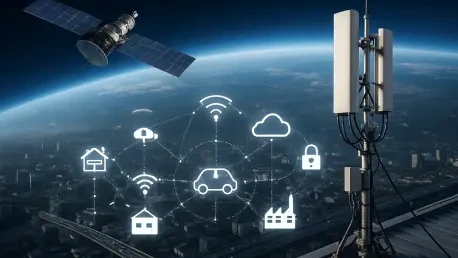Imagine a world where even the most remote corners of the planet are seamlessly connected, where IoT devices in isolated regions communicate as effortlessly as those in urban hubs, and where no location is left offline. This vision is rapidly becoming reality through a groundbreaking collaboration between a Barcelona-based satellite communications startup and a leader in low-power cellular solutions. Their recent achievement of connecting a 5G IoT device to low-Earth orbit (LEO) satellites marks a pivotal step forward in bridging global connectivity gaps. With roughly 75% of the Earth’s landmass lacking terrestrial cellular coverage, this innovation promises to revolutionize Internet of Things (IoT) and machine-to-machine (M2M) applications. By leveraging LEO satellites as orbiting cell towers, this partnership is set to transform industries ranging from agriculture to defense, ensuring that no location is left offline. The implications of this development are vast, offering a glimpse into a future of true digital inclusion.
Pioneering Space-Based 5G Connectivity
The collaboration has successfully demonstrated an end-to-end message transmission using a standard IoT module, connecting seamlessly to LEO satellites without the need for hardware modifications. This achievement mirrors the roaming experience of terrestrial mobile networks, making it a game-changer for global connectivity. The technology supports Narrowband IoT (NB-IoT), a cost-effective solution compared to traditional satellite systems, which often require expensive, specialized equipment. By functioning as cell towers in space, these satellites extend coverage to underserved and remote areas, addressing a critical barrier to IoT expansion. Industries such as logistics, energy, and environmental monitoring stand to benefit immensely, as consistent connectivity enables real-time data collection and decision-making in previously inaccessible locations. This breakthrough not only showcases technical feasibility but also highlights a scalable model for hybrid connectivity, blending satellite and terrestrial networks to create a unified communication ecosystem.
Transforming Industries with Global Reach
Reflecting on the impact, this milestone in satellite-enabled 5G IoT connectivity has proven to be a catalyst for innovation across diverse sectors. The ability to deploy low-power, standards-compliant devices in remote regions has opened new opportunities for applications in cybersecurity, mining, and agriculture, among others. Strong market traction is evident through significant contracts and funding secured by the satellite startup, underscoring commercial promise and investor confidence. Looking ahead, the focus should be on expanding the constellation of LEO satellites to ensure broader coverage and reliability. Stakeholders must also prioritize integrating this technology with existing infrastructure to facilitate seamless adoption. As hybrid connectivity models evolve, continuous collaboration between tech leaders will be essential to address operational challenges and drive down costs further. This development has positioned Europe as a frontrunner in space-based telecommunications, setting the stage for sustained advancements in global digital access.









